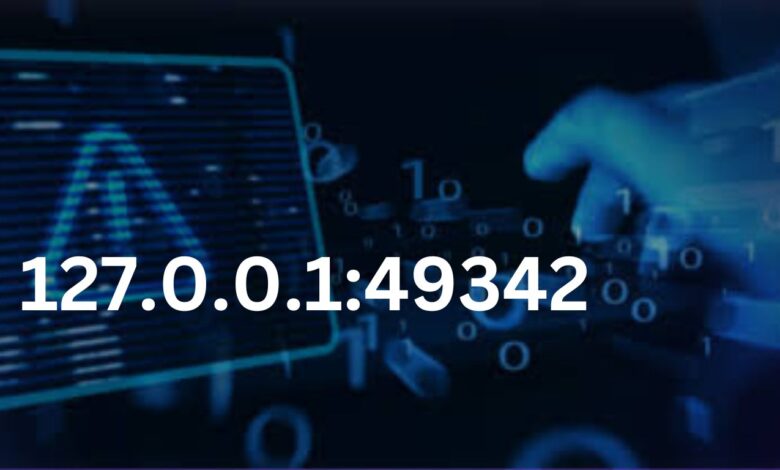Understanding 127.0.0.1:49342: Guide to a local Host

In the world of networking and computers, terms like 127.0.0.1:49342 may seem confusing, but understanding them is essential. Whether you’re setting up a website, troubleshooting a network, or just curious about how things work online, this article will explain the meaning of 127.0.0.1:49342 in a simple and easy-to-understand way. We’ll break down these concepts and explore their role in computer networks, IP addresses, and ports. By the end, you’ll have a clear understanding of how this works and why it’s important.
What is 127.0.0.1?
127.0.0.1 is an IP address, specifically known as the loopback address. In simpler terms, it allows your computer to communicate with itself. This may sound strange, but it’s actually quite useful in various networking tasks, especially for developers and IT professionals.
Key Points:
- Loopback Address: It refers to the address that routes traffic back to the device itself.
- IP Version 4 (IPv4): It is part of the IPv4 standard for Internet communication.
- Common Use: It’s often used for testing and troubleshooting network applications.
Example
Imagine you’re running a web server on your computer. Instead of using an external IP address, you can access it directly by typing 127.0.0.1 into your browser’s address bar. This allows you to test how a website works without needing an internet connection.
What is 49342?
49342 is an example of a port number. Ports are like channels that your computer uses to communicate with different services. In networking, ports are paired with an IP address (like 127.0.0.1) to allow specific types of data to be transferred.
Key Points:
- Port Numbers: These range from 0 to 65535, with specific numbers designated for different types of services.
- Dynamic/Private Ports: The port number 49342 falls in the dynamic or private range (49152 to 65535), often used for temporary or custom communication needs.
- Purpose: Applications use port numbers to route data to the correct place on a system.
Example
When you run a web application, the web server might use port 49342 for handling specific requests. The combination 127.0.0.1:49342 tells the computer to handle the request locally, on port 49342.
Understanding IP Addresses and Ports Together
When combined, 127.0.0.1:49342 refers to the local computer (using the loopback address 127.0.0.1) communicating over port 49342. This is typically used in development and testing environments. Here’s how they work together:
Breakdown:
- IP Address (127.0.0.1): This ensures that the communication stays within your device, not going out to the broader internet.
- Port (49342): This routes the data to a specific application or service on your computer.
Why Use 127.0.0.1:49342?
- Testing: It’s perfect for web developers testing websites or applications on their local machines.
- Security: It doesn’t expose the application to the internet, keeping it secure while in development.
- Convenience: You can troubleshoot and configure everything locally without needing a remote server.
Practical Uses of 127.0.0.1:49342
127.0.0.1:49342 plays a significant role in various technical scenarios. Let’s look at some common cases:
1. Local Web Development
When a developer creates a website, they often need to test it locally before launching it online. Using 127.0.0.1 allows them to check the website’s behavior without making it publicly available.
- Example: A developer might run a local web server and access it via 127.0.0.1:49342 in their browser to test how the site looks and functions.
2. Application Testing
Many applications, like databases or game servers, use 127.0.0.1 to ensure that they’re functioning properly without needing external network access.
- Example: When running a database like MySQL on your local machine, you might connect to it using 127.0.0.1:49342, ensuring that all testing happens within the local environment.
3. Network Troubleshooting
IT professionals often use 127.0.0.1 to diagnose network problems. By using tools like ping with the loopback address, they can test whether their system’s networking stack is functioning.
- Example: Running
ping 127.0.0.1in a command prompt checks if the computer’s network interface is working correctly.
4. Gaming Servers
Gamers setting up local servers for multiplayer games often use the loopback address with a specific port.
- Example: A user hosting a game might connect to 127.0.0.1:49342 to play and configure the server locally before inviting others.
FAQs about 127.0.0.1:49342
1. What does 127.0.0.1 represent?
It represents the loopback IP address, which allows a device to communicate with itself.
2. Why use port 49342?
Port 49342 is part of the dynamic or private port range, often used for temporary or application-specific tasks.
3. Is 127.0.0.1 the same as localhost?
Yes, 127.0.0.1 is the IP address for localhost, which is the hostname used to refer to the local machine.
4. Can I use any port number with 127.0.0.1?
Yes, but different ports may be used for different services. Some port numbers are reserved for specific protocols, like 80 for HTTP and 443 for HTTPS.
5. Is 127.0.0.1 secure?
Yes, it is secure for local use because the traffic stays on your machine and does not interact with external networks.
6. How do I access 127.0.0.1:49342?
You can access it by typing http://127.0.0.1:49342 in your browser or by configuring a specific application to use that address and port.
Troubleshooting Tips for 127.0.0.1:49342
If you’re having trouble using 127.0.0.1:49342, here are some common issues and solutions:
1. Port Already in Use
Sometimes, the port might be occupied by another application. You can change the port number or close the application using the port.
Solution: Run the command netstat -ano to find which application is using the port and close it.
2. Firewall Blocking Access
Your firewall settings might block access to the port.
Solution: Check your firewall settings and ensure that it allows traffic on port 49342.
3. Service Not Running
If the service or application you’re trying to access on 127.0.0.1:49342 is not running, you won’t be able to connect.
Solution: Verify that the service is running by checking the task manager or service configuration.
Conclusion
127.0.0.1:49342 may seem like a complex string of numbers at first, but it’s a vital part of how computers and networks communicate locally. Whether you’re a web developer, IT professional, or gamer, understanding how this IP address and port combination works can help you troubleshoot and configure applications effectively. By keeping all the traffic on your own machine, it ensures secure and efficient testing, development, and troubleshooting.
Final Thoughts
Knowing about 127.0.0.1:49342 can empower you to handle technical issues more efficiently. It may seem technical, but once you break it down, it becomes clear that it’s a simple and powerful tool for managing local networks and applications. Whether you’re working on local web development, troubleshooting, or setting up gaming servers, mastering this concept is key to smoother digital experiences. new orleans pelicans vs lakers match player stats



